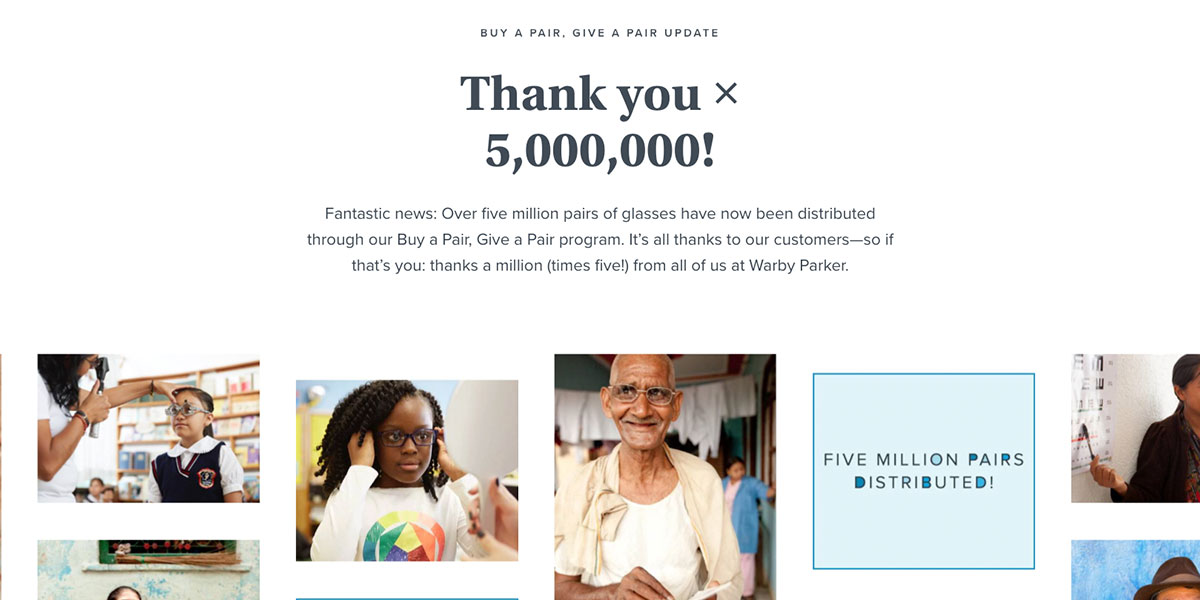Have you heard of cause-related marketing? It’s becoming something of a buzzword as more and more charities are partnering with established businesses and seeing amazing results. But what is it? Is it safe? After all, as a non-profit organization relying on donations, you must be careful who you associate with. Your brand is everything.
In this post, we share several examples of mutually beneficial cause-related marketing campaigns. In addition, we’ll cover how to determine if a for-profit organization is a good partnership candidate, and we’ll go over the crucial questions you should ask yourself before agreeing to a partnership. Read on.

What is Caused-Related Marketing?
Put simply, cause-related marketing, also known as CRM, is a mutually beneficial collaboration between a nonprofit organization and a corporation or other for-profit entity. The aim of this collaboration is to produce profits for the corporation and to advance the cause of the non-profit.
The first known use of the term dates to 1983 when American Express launched a campaign to raise funds for the restoration of the Statue of Liberty.
Over the duration of the project, every time an American Express cardholder used their card, the company donated one cent to the restoration project. In the end, the Restoration Fund received over $1.7-million from American Express. Meanwhile, American Express saw a 27% increase in card use.
A study conducted by Cone Communications found that 9 out of 10 millennials, 91 percent of those surveyed, preferred brands that associated themselves with a cause. Additionally, when looking at Americans of all ages, 85 percent said they would switch to a brand associated with a charitable organization or non-profit.
More and more, consumers want to engage with corporations who demonstrate that they’re not all about the bottom line.

An Analysis of the Consumer
Need more evidence that consumers respond to CRM partnerships?
A study conducted by marketing agency Good.Must.Grow found that consumers are indeed more likely to buy products from ‘socially responsible’ companies. The study consisted of a poll of 1,015 Americans. Not the largest sample size, true, but over one-third of respondents claimed to have consciously sought out companies that demonstrate ongoing concern with the welfare of their customers and employees. In other words, these are corporations that demonstrate they care about more than fulfilling promises to shareholders.
60 percent of study participants indicated that buying goods and services from ‘socially responsible’ consumers was important to them.
At the same time, however, the research shows that these same consumers question the motives of corporations who partner with non-profits. 63 percent of respondents indicated that they ‘only sometimes’ trust claims that a given corporation is ‘socially responsible.’
This underscores the need for both parties to consider the partnership from every possible angle before making the plunge.
Preliminary Considerations
If you’re a non-profit looking to partner with a company, consider the following:
• Find the right fit. We’ll go into this a bit more in the next section. But for now, know that consumers are more likely to support cause-related marketing campaigns if the corporation and the non-profit’s motives are aligned. For instance, an anti-obesity organization would do well to partner with an athletic footwear company but would want to stay away from partnering with “big soda,” such as Coca-Cola or Pepsi.
• Demand transparency. When working with any for-profit organization, make it clear up front that you require total transparency about all cause-related efforts. This covers everything from marketing to distribution of funds. You should be able to track at any time how much money was made, and where it went.
• Make sure they stand for something. Take care to partner with a company that has demonstrated in the past that they care about something other than the bottom line. If corporations are indeed people, that means they’re corporate citizens of their nation and of the world. Only partner with good corporate citizens. How does your prospective partner treat the environment? Their customers? Their employees?

Considerations: A Deeper Look
There are several implications from the Cone Communications study to explore in more detail. First, consider that 38 percent of millennials use social media to share positive information about companies and issues they care about. In addition, according to the study, 33 percent use social media to learn more about specific issues and the companies that are helping combat them.
These figures may seem paltry on the surface, but they become significant when you consider that CRM allows you to position your brand—or charity—in front of a new audience. When a charity partners with a business, for instance, they gain access to a new demographic that may be sympathetic to their cause. If the match is a good one, both parties stand to benefit.
In a fund-raising scenario, the non-profit will receive some of the money raised by the corporation during the drive. The corporation, on the other hand, leverages the non-profit’s brand recognition to generate goodwill with the public.
Naturally, this raises important concerns for both parties.
Consider the ill-fated partnership between the Susan G. Komen Foundation and KFC, for instance. Shortly after the two announced their partnership, research was released that showed that obesity contributes to breast cancer risk. Partnering with a corporation that provides high-fat, high-carb fast food may not have been the best move. Colonel Sanders, for his part, suddenly found himself under scrutiny from health watchdogs.
What to Look for in a Partnership
If you’re a charity looking to partner up, look for these qualities in a corporation:
• Doesn’t contradict your cause or clash with it
• Has a good reputation and is viewed positively by the shopping public
• Has a track record of ethical business practices
• Has a track record of successful marketing campaigns
• Is responsive when you raise concerns
You really can’t be too careful, here. As a non-profit, the ball is in your court. The business wants to use your good name and reputation, so take your time and go with a company you’re sure you can trust.
Ask Yourself…
Question to ask when considering a CRM partnership
There are several questions you should ask yourself when considering a CRM partnership. We’re sure you can think of several more, but here are a few to get you started.
#1. Is the company’s audience compatible with yours?
Do some analysis of their ideal customer. Can you come up with a few buyer personas for this business? Would these customers be sympathetic to your cause? An obvious example of compatibility here might be between a corporation that designs, manufactures and sells toys for dogs and a charity that raises money for dog shelters. In this case, their customers should be open to the idea of donating money to your cause.
#2. Can you stand behind this company?
Would you be willing to endorse this company and its practices to date? After all, that is effectively what you will be doing.
#3 Do you have the capacity to manage and nurture this relationship?
There’s little point in seeking a partnership with another entity if you can’t pull your weight. You know how much work goes into managing relationships with volunteers, suppliers, donors, and sponsors, so ask yourself whether you really have the bandwidth to handle another relationship. Sometimes, the honest answer is no.
#5 Will you have equal say?
There’s no doubt that partnering with a massive corporation can help you raise awareness for your own cause. You will build brand recognition. But make sure going in that you’ll both have a say in how the campaign is run. Even if the for-profit is footing the bill for marketing, don’t let them shut you out. Remember, your brand will appear on all marketing materials.
Finally, make sure that you’re comfortable with the marketing techniques they will use.
#4 Are there any legal ramifications?
If the partnership requires you to sign anything, you must get the agreement analyzed by a lawyer, preferably one who specializes in corporate law. Have your lawyer look for ‘gotchas,’ such as:
• Any blanks in the contract that haven’t been filled
• Poorly outlined rights and responsibilities for both parties
• Obtuse provisions for remedies in case something goes wrong
• No mention of risk allocation
• No mention of causes for termination
• No mention of the resolution of disputes
• Several hold harmless provisions in their favor
• …And much more
Seriously, get the contract looked at by a qualified attorney before signing.

The Future of CRM
As we’ve seen, cause-related marketing resonates with millennials, and with the population overall. Consequently, CRM, if done properly, can be a boon to both the non-profit and the corporation. Next, we’ll look at what the future holds for CRM and how you can take advantage.
Growth, Growth and more Growth
Holding businesses accountable for how they treat their people, their customers and the world at large is trendy. According to the Cone Communications 2018 Cone/Porter Novelli Purpose Study:
• 78 percent of Americans believe companies have a responsibility that goes beyond just making money for their shareholders
• 77 percent of consumers feel more connected with companies that demonstrate concern about the environment and the world at large
• 68 percent of consumers want to share content about companies that demonstrate social responsibility
• 66 percent said they would be willing to change their buying habits by switching to a socially-conscious company
According to For Momentum, a cause marketing firm, more than half of consumers surveyed want the companies they buy from to participate in charitable initiatives such as #GivingTuesday.
More and more businesses are starting to realize that CRM is no longer optional. This gives you, as the non-profit, a great deal of choice when considering a partnership.
Companies are Asking Consumers to Change
There are examples of for-profit organizations urging consumers to make changes of their own accord, even if those initiatives are profit-driven. For instance, CVS is well-known for urging customers to give up smoking, with their on-going Quit Smoking campaign. AT&T, meanwhile, has its “It Can Wait” pledge campaign that urges drivers to forgo texting while behind the wheel. Or consider the SparkStart campaign from New Balance, which encourages consumers to get more exercise.
When looking to grow your non-profit brand by partnering with a corporation or other for-profit company, seek forward-leaning companies like these first. They’re more likely to be receptive to your pitch.
A cynical analysis of the driving force behind this new-found initiative from for-profit companies would indicate that it’s an effort to reach Generation Z. As we’ve seen, younger consumers want to associate themselves with companies that appear to care about social issues and the environment. Getting Generation Z behind them isn’t a bad plan. After all, this is the first generation of truly ‘digital natives,’ which means that getting them on board will help your campaign soar.
More Channels than Ever
However, one consequence of reaching out to digital natives is that you’ll need to cover more ground to find them. In 2015, When Coca-Cola sought to launch a campaign to aid in the fight against cyberbullying, they started with a single Super Bowl ad. But they quickly found that reaching their target audience required not only TV ads, but also streaming video ads, social media marketing, content marketing and offline advertisements.
Generation Z are everywhere, and the demands on their time and attention are huge.
Bad Partnerships Don’t Go Unnoticed
All of this means, of course, that when a partnership turns sour or never takes off, people notice. You’re depending on your for-profit partner to act in good faith. Consumers demand good practices in cause marketing because the charities and causes involved are near and dear to their hearts. Any entities acting in bad faith are called out.
Examples of Stellar Cause-Related Marketing Campaigns

#1 RED KETTLE
The Salvation Army recently partnered with DipJar and numerous local retailers to augment their Red Kettle cause-related marketing campaign. In case you have somehow never encountered it, Red Kettle is a yearly campaign that takes place over the holidays. Participating retailers allow volunteers to stand outside their shops accepting donations from passerby. More and more, though, consumers don’t carry cash. To address this, The Salvation Army partnered with giving kiosk company DipJar. The partnership allows the Salvation Army to accept donations via credit card on the spot.
Volunteers placed branded DipJars inside participating retail stores. We don’t have hard data on how successful this partnership was, but there’s good reason to suspect that it was successful. Providing a cash-free method of donation removes one barrier to giving. At the same time, it provides social pressure for people to do so. Last, all of this occurs at a time of year when consumers are more inclined to give to charity.

#2 RED NOSE DAY
Originating in the United Kingdom, this cause-related marketing campaign is a collaboration between Walgreen’s and Red Nose Day, an on-going effort to eliminate childhood poverty. During the six-week drive, customers purchase comical red noses and take group pictures. All proceeds go to affiliated charities. It’s a fun, light-hearted example of cause-related marketing done right. Because group photographs are built right into the process, the campaign is highly shareable.

#3 FUNDRAISER FOR THE PLANET
Patagonia, a designer of outdoor clothing and gear, partnered with several environmental protection organizations. The Fundraiser for the Planet occurred on Black Friday, and Patagonia gave 100 percent of proceeds to participating charities.
Patagonia didn’t specify which charities received the funds, but they did say that the participating charities were all ‘under-funded’ and ‘off-radar’ non-profits. The initiative raised over $10-million.
This is a powerful example of cause-related marketing as it didn’t require consumers to do anything special. All they had to do was show up. Patagonia increased their brand profile, and the charities raised funds. Everyone wins.

#4 THE FACES OF DIABETES
The Faces of Diabetes, a non-profit dedicated to busting stereotypes surrounding diabetes, partnered with several local businesses to raise money. Another non-profit utilizing wireless credit card terminal technology from DipJar, the company accepted donations from patrons at many locations in Alabama. As with the Red Kettle Campaign, this case demonstrates that consumers are more willing to give a little if they can do so with their credit card. What’s more, local businesses were happy to help as they didn’t need to integrate DipJar’s technology into their existing POS systems.

#5 BUY A PAIR, GIVE A PAIR
Warby Parker, an online retailer of prescription glasses and sunglasses, partnered with VisionSpring and other charities to help those less fortunate get access to the eyewear they need. To accomplish this, the company uses a simple buy one, give one model. For every pair of glasses they sell, they donate a pair to a partnering charity.
In addition to providing glasses and sunglasses, some of their non-profit partners train men and women in developing countries to administer basic eye exams.
Because Warby Parker is primarily an online retailer, and because their website receives a fair amount of traffic, this strategy works especially well for them. Consumers are more than happy to spread the news about the buy one give one campaign.
#6 PURPOSEFULL
For years, fast food restaurants have used their access to the public to raise money for charitable causes. McDonald’s, for instance, has Ronald McDonald’s House Charities. Now, Arby’s, through its “PurposeFULL” campaign, asks for donations at their POS in participating stores. So far, the initiative has raised over $15-million. The beneficiary is the non-profit organization Share Our Strength, which raises awareness of malnutrition in American children.
This type of cause-related marketing is successful because it represents a simple, binary proposition. Employees are trained to ask customers if they would like to donate a dollar, or some other low amount, as they make a purchase. This approach may make customers feel a bit put on the spot, but there’s no doubt that social pressure leads to donations.
#7 SOAR WITH READING
JetBlue has partnered with FirstBook to create the Soar With Reading campaign. The aim of this cause-related marketing campaign is to encourage children in low-income neighborhoods to establish the habit of reading for pleasure and learning. To accomplish this, JetBlue, an airline headquartered in New York City, donates money to the charity on a regular basis.
FirstBook, for their part, manages an innovative free book vending machine campaign in low-income areas, giving children of all ages access to quality reading materials in an engaging, appealing manner.
What’s more, JetBlue encourages their staff to volunteer with the Soar With Reading campaign so they can be directly involved in encouraging a new generation to embrace reading.
I hope this concise post has helped clarify some of the finger points of cause-related marketing. What’s your take? Would you ever partner with a corporation to increase revenue?


